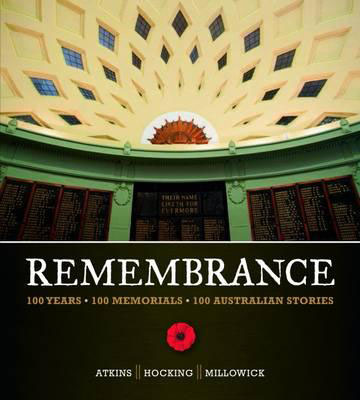by Geoff Hocking with Christopher Atkins and Julie Millowick
At first glance, Remembrance appears to be a picture book about memorials – but it is significantly more than that. The 100 stories associated with the 100 memorials are well researched and told; and the present is linked with the past. Each story covers one or two pages and so the collection is able to be enjoyed in short sittings.
In a distinctively original and captivating way, Remembrance shows how the terrible sacrifice of young Australians in World War I reverberated across the country at the time; and how the memories continue to resonate in so many different ways.
Selected for their unique design, their grandeur or their simplicity, the 100 memorials have been arranged alphabetically and represent the diversity of memorials from each state and territory across Australia. Australian memorials in Turkey, France and Belgium have also been included.
Geoff Hocking is an Australian author, artist and graphic designer who has written, illustrated or designed more than 30 books for both adults and children. He has written extensively on Australian themes: bushrangers; Catholic rebels; gold-diggers; and the story of the Australian flag. Hocking’s books are always lavishly illustrated with hundreds of old engravings, paintings, artworks and ephemera and have become definitive collections of visual representations of his themes.
Hocking produced Remembrance in conjunction with Christopher Atkins and Julie Millowick – fellow lecturers at La Trobe University. Atkins was a contributing photographer and writer. Millowick managed the many contributing photographers studying photojournalism at La Trobe University.
Remembrance begins with a useful introductory section titled ‘In Memoriam’ and an introduction by Derek Guile. While the book’s images are first rate and of a good size, the text for the stories and the captions is a bit small and some older readers may struggle. Remembrance includes a bibliography and notes section, but the index seems a little shorter than I would expect for such a significant work with so many stories.
As a book about memorials and memory, perhaps it may have been more appropriate for Remembrance to have been published in 2018 or 2019 on the centenary of the when the memorials were mostly constructed – but then again, a casual reader may well take the next four years to work through the 100 stories.
In all, Remembrance is a well-researched, well-presented and entirely readable coffee table style book that is a fitting tribute both to the memorials that were created to honour World War I’s fallen and to the men and women themselves.
Reviewed by Marcus Fielding
Contact Marcus Fielding about this article.






